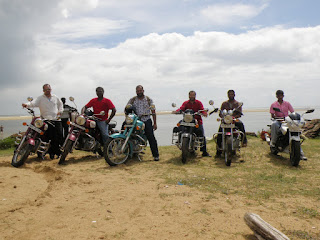The day started for most of us at 5.30am and everyone one where geared up and ready at the starting point (Besant Nagar beach). As everyone ready to leave the heaven's opened. We waited for 15 mins there was no sign of rain stopping. We decided to start anyway and Amith on his C500 took the lead followed by Siva on his C350, Ramkumar on his C500, Mothi and Selvam (pillion) on TBTS, Rajesh on his spanking new Apache RTR 180 and I was in the sweep. Before we could hit ECR we had to ride through almost knee deep water at places and everyone got wet to their bones in the first few kilometers itself. We hit ECR and the within 10 minutes of riding the rain stopped but the roads were really wet. We road on a single file formation. We took a couple of breaks in-between. I was forced to ride behind Rajesh and he couldn't go more than 60kph because he was running-in his bike. It was very frustrating and finally we reached Mahabs were we had a decent breakfast.
We were in no hurry and slowly puttered our way back to ECR from Mahabs and kept riding. The roads were damn neat, damp and so no dust and pleasant weather but overcast but all of us were still wet. And 60kph speed didn't help the drying process either. After Kalpakam I lost my patience and ripped. The Megaphone was roaring to glory and comments I got from the fellow riders was that even their listening to music and riding at 60-80kph the only thing they heard was me zipping past them. Maybe thats when I realized that Megaphone was a bad idea for group rides as its prone to irritate others. But that being said "Loud pipe does save lives." I saw people crossing the rode at intersections and when I was riding slow I had to blow my horn considerably to alert my presence. But that also didn't help sometimes because these folks are used to blaring horns. Different story when I ripped. People were running for their lives and no one in that vicinity had the balls to step on the road.
Reached Alamparai Fort by 10ish. Scouted the place for few minutes and decided to take the bike up the sand path up to the backwaters. Here where all the fun started. About 400m of off-roading. The bikes slipped and slided. It never for once go in a straight like and the OEM zappers are no good for off-roading. By this time Amith and I reached the backwaters and headed back on foot to help the others. Everyone struggled except for Mothi :D. All the bikes picked up sand and sprayed it on the brand new Apache. But eventually everyone made it to the top and were satisfied.
The location was perfect and the sun started to shine. Perfect place to relax and dry our clothes. Some explored took a swim in the backwaters, some explored the fort and some just lazed around. We spend mre than an hour and next time we have to buy some ration before coming here.
We started to Pondy and reached Promenade by 12.30pm... Relaxed for while at the Leather Bar and headed towards "La Terresse" for pizzas and sizzlers. We tanked up the bike and by that time we were ready to head back it was 4.15pm. We decided to have just one re-grouping point at Kalpakam. Mtself and Amith maintained and good speed of 80-90kph while Mothi was at a brisk 70-80kph and Ramkumar at a sedate 60kph and Siva didn't have an option and had to tag Ram. Myself and Amith stopped at a backwater for some final snaps of the trip and reached Kalpakam for the re-grouping.
Now it was officially dark and we could see thunderstorm at the horizon. Me wanted to get back home at the earliest because a headache started to creep up. Switched on the driving lights which proved to be a life saver when traffic from the opposite side were on high-beam. Ripped through the damp roads and then it started raining for a bit. The headlight glare was blinding but didn't give a damn. Concentrated hard and reached home by 8. Within 30 minutes everyone reached their home safely. Me had after effects. The food at La Terresse made me sick and had to throw up what ever I had for lunch. Grr.. I guess the meat was not cooked well and decieded not to go there from here on and stick with Promenade or Rendevous for food.
Butr whatever the be the case, ride along ECR has no parallels. Flawless roads with beautiful scenery. We never get tired of riding there. As far as I'm concerned, "There is ECR then there are roads".





















